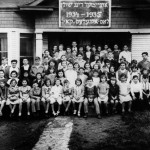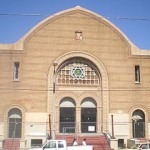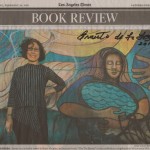Boyle Heights
All I knew, when I started to do research for The Tin Horse, was that I wanted to write a novel “starring” a minor character from The Big Sleep, the noir classic by Raymond Chandler. The character was a keenly observant woman who worked in a Hollywood bookstore; unnamed, she was identified as “an intelligent Jewess.“ Ergo, my character had to be a Jewish woman living in L.A. in around 1940. And I sensed that, despite her brief role in The Big Sleep with its mean streets and glittery night life, the Jewess inhabited a very different Los Angeles.
I had no idea that my search for her Los Angeles would lead to a mother lode: a piece of Los Angeles and Jewish history so juicy that the setting became a character in its own right.

Boyle Heights Workman’s Circle class photo, ca. 1935
L.A. Public Library, “Shades of L.A.: Jewish Community”
That place was Boyle Heights, a neighborhood directly east of downtown L.A. Between the First and Second World Wars, Boyle Heights was the Jewish working class area of Los Angeles. It was the first L.A. site of Canter’s Deli (an L.A. institution) and of a barbershop owned by a man who later went into the beauty business, Max Factor. On a less savory note, it was also the boyhood home of gangster Mickey Cohen. As I ended up describing it …
“… you could walk in either direction from the corner of Brooklyn and Soto and pass kosher bakeries and delicatessens with barrels of sharp-smelling pickles and matyas herring sitting out front. Canter’s was the deli where all of the junk men had breakfast and a shot of whiskey every morning at six, and every year before Passover it was the site of the crying man-a man who sat on the sidewalk in front of Canter’s, tears running down his face. … Stores had signs in both English and Yiddish, and there were Yiddish workers’ societies, community centers, and socialists debating outside the vegetarian cafe.”
I knew all this because of a fantastic oral history project conducted by the Jewish Historical Society of Southern California in the mid-1990s. They interviewed about two dozen people who had grown up in Jewish Boyle Heights, and a delightful part of my research involved listening to these reminiscences, rich with details of everyday life and enlivened by the interviewees’ personalities. The oral history project was the basis for “Meet Me at Brooklyn and Soto,” a video produced and directed by Ellie Kahn, in which the late Huell Howser, the wonderful chronicler of California life, toured the neighborhood (available in VHS). BTW, Ellie recently posted a video on YouTube, focusing on the Breed Street Shul (down the street from Elaine), that has some fantastic archival footage of Boyle Heights when Elaine would have lived there.
Boyle Heights wasn’t just a Jewish neighborhood, though. Since it was a low-rent area with no restrictive housing policies, it attracted a sort of League of Nations of residents. Jews were the largest group, about 40% of the population. But there were also sizable Japanese- and Mexican-American communities, African-Americans, and dozens more; in the oral history interview with Judge Harry Pregerson, he said that his fellow students at Roosevelt High School came from 52 different ethnic groups. This was long before diversity became a cultural value; in fact, in a 1939 report by the Federal Home Owners’ Loan Corp, Boyle Heights was “redlined”-literally, colored on a map in red-for its “subversive racial elements.” Now, however, Boyle Heights in the 30s looks like a bold albeit accidental utopian experiment. And, remarkably, the experiment succeeded. People who grew up in Boyle Heights during those years speak with pride and love about their multi-ethnic community.
After World War II, many Jewish families left Boyle Heights for the West Side or the San Fernando Valley. But a number of Jews, particularly leftists, stayed, and joined forces with Mexican-Americans as community activists. USC historian Dr. George Sanchez (who grew up in Boyle Heights) discusses this alliance in an article in the American Quarterly, “What’s Good for Boyle Heights is Good for the Jews: Creating Multiculturalism on the Eastside in the 1950s.” Dr. Sanchez is also coming out with a book in the near future.
Some years ago, Brooklyn Street was renamed Cesar Chavez Avenue, and the neighborhood is now almost completely Latino. With the death of Eddie Goldstein in early 2013, Hector Becerra at the Los Angeles Times wrote about losing “the last Jewish man of Boyle Heights.” (You can see my blog about this for the Jewish Book Council.) For some looks at Boyle Heights today, see these terrific blog posts by urban explorer-foodie Aunt Snow: “Boyle Heights tastes and sights,” “A Moveable Feast,” and “Dancing in the Parking Lot.”
Still, the Jewish connection to Boyle Heights endures. The Breed Street Shul Project, part of the Jewish Historical Society  of Southern California, is working to restore the neighborhood’s grandest old synagogue, Congregation Talmud Torah. The smaller of the shul’s two buildings reopened in 2011 and is being used for events for both the Jewish and Mexican-American communities, from Bar Mitzvahs to a pre-Grammy party featuring artists with East L.A. roots who’d been nominated (including Grammy winner Quetzal).
of Southern California, is working to restore the neighborhood’s grandest old synagogue, Congregation Talmud Torah. The smaller of the shul’s two buildings reopened in 2011 and is being used for events for both the Jewish and Mexican-American communities, from Bar Mitzvahs to a pre-Grammy party featuring artists with East L.A. roots who’d been nominated (including Grammy winner Quetzal).
Residents, past and present, continue regard Boyle Heights with pride. When The Tin Horse came out, I was honored to speak at an event-a conversation with George Sanchez-sponsored by the Jewish Historical Society and Boyle Heights Historical Society. I was touched by what a diverse group attended-Jews who’d grown up in Boyle Heights or who’d connected to this important piece of L.A. Jewish history and also many Mexican-Americans who lived in Boyle Heights either now or in the past. Artist Vidal Herrera gave me a version on canvas of his vibrant painting “Greetings from East L.A.” And I met muralist Ernesto de la Loza, whose  beautiful mural-just down the street from the Breed Street Shul-was the backdrop for a photo of me that ran in the Los Angeles Times. He had me sign his copy of the article, and I had him sign mine.
beautiful mural-just down the street from the Breed Street Shul-was the backdrop for a photo of me that ran in the Los Angeles Times. He had me sign his copy of the article, and I had him sign mine.
Harriet Rochlin was there, too. A very special part of doing my research was meeting Harriet, a historian/writer who grew up in Boyle Heights and is the co-author (with her late husband, Fred) of the history Pioneer Jews. Harriet was terrifically helpful to me when I was working on the book, and what a role model! Check out her web site for her eloquently written Boyle Heights memories and other information on Western Jewish history.
If you’d like to do some research of your own, I’m listing some of my main references below. And currently – through January 2014 – the Autry National Center is offering a superb opportunity to learn more about the Jewish presence in Los Angeles through its exhibition “Jews in the Los Angeles Mosaic.”
Web Sites
Boyle Heights Historical Society
Los Angeles Jewish Journal – I mention a few articles below, but if you search their site for Boyle Heights, you’ll get a lot
Books and Articles
About the Jewish immigration experience:
To the Golden Cities by Deborah Dash Moore (Harvard University Press)
World of Our Fathers by Irving Howe (New York University Press)
Finding Home: In the Footsteps of the Jewish Fusgeyers by Jill Culiner (Sumach Press)
About Jews in Los Angeles and the West:
Pioneer Jews: A New Life in the Far West by Harriet and Fred Rochlin (Mariner Press)
The Jews of Los Angeles: Urban Pioneers, Norton B. Stern, ed. (Southern California Jewish Historial Society)
About Boyle Heights:
Boyle Heights: Recollections and Remembrances of the Boyle Heights Jewish Community in Los Angeles 1920s-1960s, Abraham Hoffman, ed. (Western States Jewish History)
Los Angeles’s Boyle Heights, images from the exhibition “Boyle Heights: The Power of Place” at the Japanese American National Museum
The City That Grew by Boyle Workman (grandson of Boyle Heights founder Andrew Boyle) (Southland Publishing Co.)
“A History of Boyle Heights,” an excellent report by Edgar, a Roosevelt High senior (This was done in 1998, and if anyone knows what Edgar’s doing now, I’d love to find out. He wrote a really good paper.)
Los Angeles Jewish Journal:
“Growing Up Jewish in Boyle Heights”
“Boyle Heights: Not Yet Forgotten”
“UCLA Mapping Project Goes Back to the Future”
“On Road to Renewal, Shul Gets Multipurpose Life”
About Rose Pesotta (whose labor organizing activities inspired Cousin Mollie’s):
Bread Upon the Waters by Rose Pesotta (Cornell University Press)
The Gentle General: Rose Pesotta, Anarchist and Labor Organizer by Elaine Leeder (State University of New York Press)
About Los Angeles history:
The Los Angeles River: Its Life, Death, and Possible Rebirth by Blake Gumprecht (Johns Hopkins University Press)
About Zionism in America:
The Americanization of Zionism, 1897-1948 by Naomi Wiener Cohen (Brandeis University Press)
The Emergence of American Zionism by Mark Raider (NY University Press)
Images of a State in the Making – Zionist posters This is how I got descriptions for the posters on the wall of Chafkin’s Grocery Store.